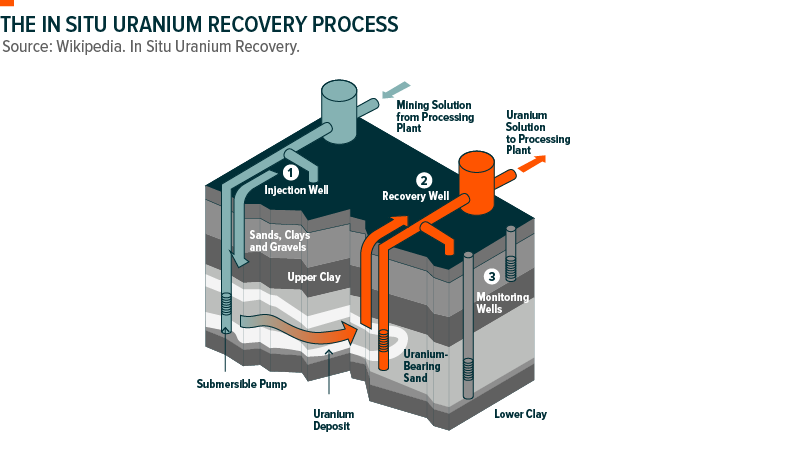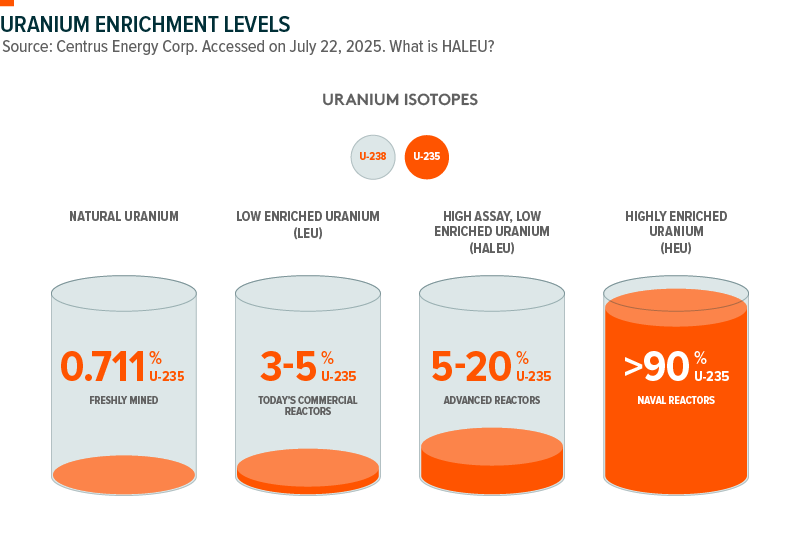Four nuclear energy names you didn’t know about
Uranium is one of the most efficient and low-carbon ways to produce energy. As the world moves toward electrification and away from fossil fuels, nuclear power is stepping into the spotlight. With countries around the globe ramping up their nuclear capacity, opportunities are emerging across the entire uranium value chain.
In this piece, we shine a light on four crucial companies currently in our Global X Uranium ETF (ASX: ATOM). Each plays a key role in powering the global shift toward cleaner, more reliable energy.
National Atomic Company Kazatomprom JSC (Kazatomprom)
Kazatomprom is Kazakhstan’s state-owned uranium producer and is headquartered in Astana. Kazakhstan accounts for approximately 43% of global uranium production, with Kazatomprom responsible for about half of that output – making it the world’s largest uranium producer by volume.(1)
In addition to its scale, Kazatomprom sets itself apart through the use of in-situ recovery — a mining method that avoids open-pit excavation by injecting acidic solutions into underground deposits to dissolve uranium ore, which is then pumped to the surface for processing. This technique is widely considered to be more environmentally sustainable and importantly, much more cost-effective than conventional mining.(2)

Source: Wikipedia. In Situ Uranium Recovery.
As a dominant player in the global uranium market, Kazatomprom has significant influence over pricing dynamics. Adjustments to its production guidance can lead to sharp moves in spot uranium prices, positioning the company as a key bellwether for investors in the nuclear energy sector.
KEPCO Engineering & Construction Company, Inc.
KEPCO Engineering & Construction Co. (KEPCO E&C) was founded in 1975 as a subsidiary of Korea Electric Power Corporation (KEPCO).(3) At the time, South Korea relied heavily on foreign engineering services to build and maintain its energy infrastructure. KEPCO E&C was created to strengthen the nation’s energy independence by designing and constructing power plants domestically. As a part of this goal, the company focused its efforts on nuclear and thermal power facilities, laying the groundwork for what would become a core pillar of South Korea’s industrial growth.
Today, KEPCO E&C stands among the global elite in nuclear engineering, procurement and construction services. Over the past decade, KEPCO E&C has been involved in multiple high-profile international nuclear energy projects, these include:
- UAE – Barakah NPP: In the 2010s, KEPCO E&C led the consortium that designed, procured, and constructed four APR-1400 reactors in the UAE, and continues to provide long-term engineering support.(4) Valued at US$20 billion, the deal marked one of the largest nuclear energy export contracts in history.
- UK – MoU with Mott MacDonald: In November 2023, KEPCO E&C signed an Memorandum of Understanding (MoU) with Mott MacDonald to explore large-scale nuclear projects in the UK, including projects like Wylfa Newydd.(5) The agreement supports regulatory licensing and site development for potential future builds.
- Czech reactor bid (via KHNP): In 2024, South Korea’s KHNP (KEPCO E&C’s sister company) was named the preferred bidder to construct two reactors in the Czech Republic.(6) The deal, worth roughly US $8.7 billion, highlights KEPCO’s growing reactor export strength.
As the nuclear energy buildout re-accelerates, the role of engineering and construction specialists like KEPCO E&C is becoming increasingly vital. KEPCO E&C has been one of the top-performing stocks in the Global X Uranium ETF (ATOM) in 2025 as of July, underscoring how investing across the full uranium value chain can help investors better capture the entire nuclear energy theme.
Centrus Energy Corp.
Centrus Energy (Centrus), formerly known as the United States Enrichment Corporation (USEC), was established in 1992 with US government backing and later privatized in 1998. Headquartered in Bethesda, Maryland, Centrus is one of the few remaining Western suppliers of enriched uranium fuel. Today, the company plays a vital role in supporting nuclear reactors around the world – most notably through its production of High-Assay, Low-Enriched Uranium (HALEU), a next-generation fuel critical to advanced nuclear technologies, including small modular reactors (SMRs).

Source: Centrus Energy Corp. Accessed on July 22, 2025. What is HALEU?
In 2025, Centrus has emerged as a cornerstone of the United States’ nuclear energy strategy, particularly as Western countries accelerate their pivot away from Russian uranium and enrichment services in the wake of the Ukraine invasion. It remains the only US company currently licensed to produce HALEU, giving it a uniquely strategic position in both energy security and innovation.
Last year, Centrus signed a multi-phase contract with the US Department of Energy (DOE), committing to produce at least 900 kilograms of HALEU by June 2025.(7) That milestone has now been met, unlocking the next phase of the contract, which extends production through mid-2026, with further options running through 2034. The company is also benefiting from strong regulatory momentum, including a US$3.4 billion federal funding initiative and new executive orders introduced under the Trump administration aimed at revitalizing the domestic enrichment sector.(8)
With strategic DOE partnerships, growing financial strength, and a critical role in the clean energy transition, Centrus Energy sits at the forefront of America’s nuclear fuel supply chain—rebuilding domestic enrichment capacity and enabling the next era of advanced nuclear deployment.
Sprott Physical Uranium Trust (U-U)
The Sprott Physical Uranium Trust (SPUT) was launched on July 19, 2021, by Sprott Asset Management. Headquartered in Toronto, the trust was designed to give investors direct exposure to the price of physical uranium, serving as a transparent, liquid vehicle for accessing the uranium market without the operational risks of mining equities.
SPUT holds physical uranium in the form of U₃O₈ (triuranium octoxide), securely stored in licensed facilities in Canada and France. Unlike futures contracts or producer ETFs, the trust’s strategy is simple: buy and hold uranium. This model exerts real demand pressure on the spot market and has made SPUT a major force in tightening physical supply.
Since its launch, SPUT has accumulated more than 80 million pounds of uranium, making it the world’s largest physical uranium investment vehicle. Its impact on the market has been profound – helping to break a years-long price slump and playing a catalytic role in the uranium bull market that began in 2021.(9)
In 2025, SPUT continues to be a key player in the nuclear energy investment landscape. It’s growth not only reflects growing investor conviction in the long-term role of nuclear power but also plays an active role in influencing uranium pricing dynamics. As the world accelerates its push for clean, baseload energy, SPUT remains a highly visible barometer of sentiment around nuclear energy and a powerful vehicle for institutional and retail access to the uranium trade.
Investing in Nuclear Energy & Uranium
We believe the most effective way to invest in the nuclear energy megatrend is through broad exposure across the entire value chain) – from uranium producers and fuel enrichment firms to engineering, construction, and infrastructure providers.
For investors looking to gain exposure to the global nuclear buildout and the broader uranium opportunity, ATOM may be worth considering. It offers diversified access to many of the key players discussed in this article, including Kazatomprom, Centrus Energy, KEPCO E&C, and the Sprott Physical Uranium Trust.

1 topic
1 stock mentioned
1 fund mentioned

